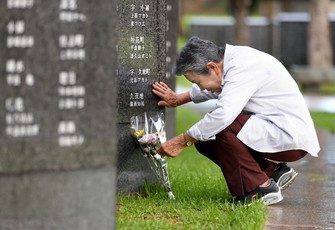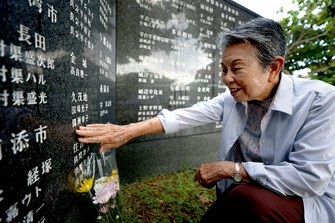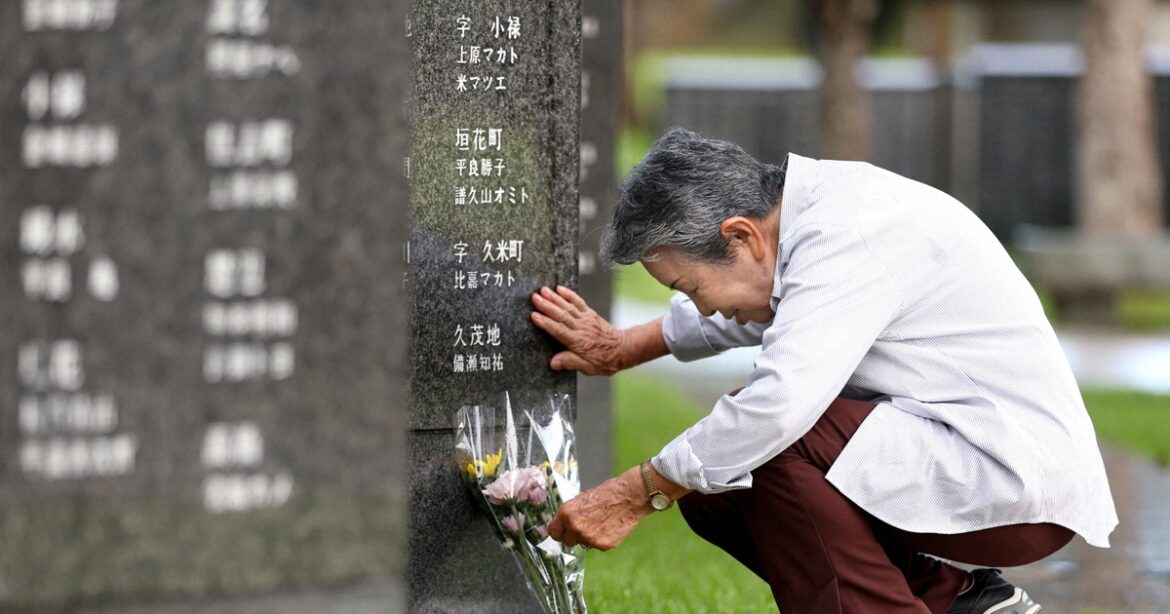
Nagasaki A-bomb survivor Tomoko Oshiro offers flowers at the Cornerstone of Peace in Itoman, Okinawa Prefecture, where her father Chiyu Bise’s name is engraved, on June 25, 2025. Her mother Sachiko’s name is also engraved a short distance away. (Mainichi/Shinnosuke Kyan)
NAHA — “I had no choice but to stay silent.” In Tomoko Oshiro’s calm words, the deep loneliness of the past was unmistakable.
Oshiro, 84, who survived the atomic bombing of Nagasaki and now resides in Urasoe, Okinawa Prefecture, has lived in Okinawa since the year after World War II ended. Under U.S. rule until 1972, Okinawa lagged behind the Japanese mainland in providing support for hibakusha, or atomic bomb survivors. For many years, Oshiro did not speak about her experiences. What changed that was her connection with other hibakusha on the island.
Oshiro was born in Osaka to her father Chiyu Bise (who died in 2004 at age 93) from the Okinawa prefectural capital Naha, and mother Sachiko (who died in 2006 at age 95). In the spring of 1945 Oshiro moved to the Motoharamachi district of Nagasaki to live with her paternal grandmother. She was 4 years old at the time. The family of five included her 1-year-old brother.
At 11:02 a.m. on Aug. 9, while Oshiro was playing at home with her grandmother and brother, the ceiling collapsed onto her head. The A-bomb had exploded, and Oshiro was only about 1.3 kilometers from the hypocenter.
“Tomo-chan, Tomo-chan.” She heard her mother’s voice as she returned from a friend’s house, and Oshiro desperately shouted “Help me!” from under the rubble. Her mother, herself burned, rescued Oshiro and carried her to a first-aid station. According to her mother’s memoir, her grandmother was blown off her feet by the blast and died despite efforts to save her life. Oshiro’s baby brother, who was on his grandmother’s back, was killed instantly, crushed against an earthen wall.
In 1946, the family moved to Okinawa. Her parents made a living as geta sandal makers and welders. Many atomic bomb survivors in Okinawa worked on bases belonging to the U.S. military, which had dropped the bomb.
The need to survive made hibakusha reluctant to speak. Taeko Kiriya, an associate professor of peace studies at Tama University in Tokyo who conducted interviews in Okinawa from 2019 to 2022, noted, “Many survivors said they hid their status because they feared losing their jobs if people found out.”
On the Japanese mainland, the 1957 atomic bomb medical law required the national government to pay for health checkups and medical expenses for hibakusha. But Okinawa was excluded.
A survey of survivors in Okinawa began in 1963, and the Ryukyu government (as it was then) started issuing survivor health handbooks in 1967 — 10 years later than on the mainland. It was only through these long-awaited checkups that they discovered glass fragments still embedded in Oshiro’s mother’s body.
When Oshiro graduated from high school, relatives in east Japan’s Kanto region warned her, “Never tell anyone you’re a hibakusha. It will affect your chances of marriage.” She obeyed, thinking, “If I’m going to be discriminated against, I have no choice but to stay silent.” The first time she confided in someone outside her family was in her late 20s, to a man she had met at work, whom she would later marry.
Worried about the effects of radiation, she told him, “I can’t have children.” Even so, she became pregnant at 25 and raised a daughter. In her 40s, she was diagnosed with thyroid cancer and uterine fibroids.

Nagasaki A-bomb survivor Tomoko Oshiro offers flowers at the Cornerstone of Peace in Itoman, Okinawa Prefecture, where her mother Sachiko Bise’s name is inscribed, on June 25, 2025. Her father Chiyu’s name is also engraved a short distance away. (Mainichi/Shinnosuke Kyan)
She never consulted colleagues or those close to her. “The atomic bomb was something that happened on the mainland. People in Okinawa wouldn’t understand how survivors feel,” she thought. She also felt guilty for not knowing or being able to talk about the suffering of the Okinawan people, a quarter of whom died in the Battle of Okinawa in 1945.
A turning point came about 25 years ago. After reaching retirement age and settling into a quieter life, she joined the Okinawa Prefecture hibakusha association, the only such group in the prefecture.
At general meetings and health checkups, survivors from across the Okinawan archipelago would gather. There, she could share feelings she had never spoken about, including her thoughts on the atomic bombing and the Battle of Okinawa. “I enjoyed talking with everyone,” she said, recalling the encouragement she felt.
Eight years ago, her only daughter was diagnosed with bile duct cancer and died at age 50. “Was my daughter’s cancer my fault?” Oshiro wondered. It was her fellow association members who helped ease her deep sense of guilt.
In the early 1980s, there were more than 350 hibakusha living in Okinawa. As of April 2025, only 68 remained. At the Peace Memorial Park in Itoman, Okinawa Prefecture, the Cornerstone of Peace bears the names of those who perished in the Battle of Okinawa and local atomic bomb survivors, including Oshiro’s parents. When she visited the monument in June, she traced their names with her hand and said, “Dad, Mom, I’m doing well.”
Since 2020, Oshiro has served as president of the survivors’ association. She says she is only able to speak out now thanks to the community built by earlier generations of hibakusha. “I hope people will not forget the journey of hibakusha on the (Okinawa) islands who lived far from the bombed cities,” she said.
(Japanese original by Shizuka Takebayashi, Kyushu News Department)


AloJapan.com